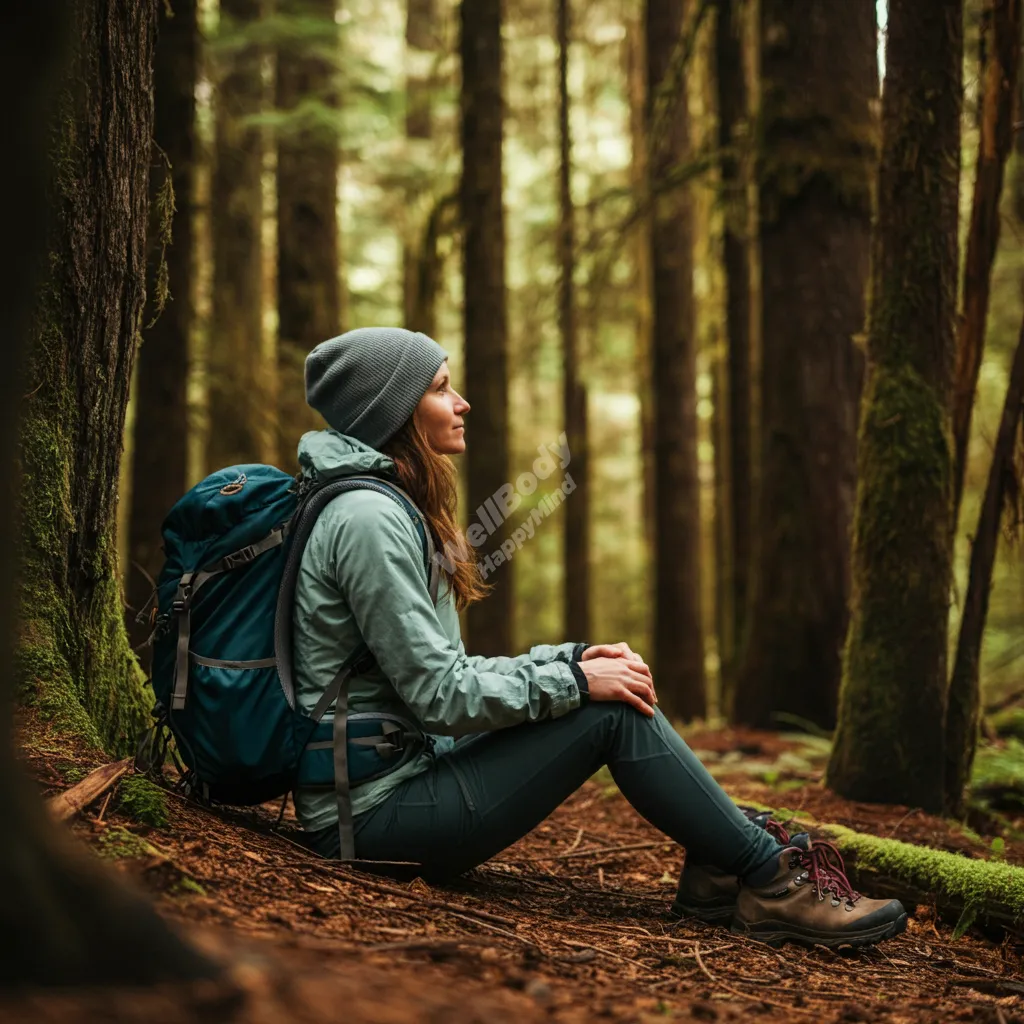The Unique Role of Nature in Deepening Mindful Awareness

Introduction:
Mindfulness is a powerful tool for peace and clarity. It helps us stay present and aware. But did you know nature can boost your mindfulness practice?
Imagine this: You’re in a forest. The air smells like pine. Leaves rustle in the breeze. Birds sing nearby. In this moment, you’re not thinking about work or worries. You’re just here, now. This is nature mindfulness in action.
A recent study found that spending just 20 minutes in nature can significantly lower stress hormones. This shows how nature can be a powerful ally in our quest for mindfulness.
In this post, we’ll explore how nature deepens mindful awareness. We’ll look at the science behind it and share practical tips. Nature offers a unique way to enhance our mindfulness practice. Let’s discover how it can help you too.
Understanding Mindfulness in the Context of Nature:

Mindfulness is about being fully present. It means paying attention to what’s happening right now, without judgment. When we practice mindfulness, we focus on our thoughts, feelings, and surroundings.
Nature provides a perfect setting for mindfulness. Here’s why:
- Nature slows us down: The pace of nature is often slower than our busy lives. This helps us pause and notice more.
- It engages our senses: Nature offers a rich sensory experience. We can see, hear, smell, and touch the world around us.
- Nature is always changing: This helps us practice staying present and observing without getting stuck.
Nature mindfulness is the practice of being mindful while in natural settings. It combines the benefits of mindfulness with the healing power of nature.
Research shows that nature mindfulness can:
- Lower stress
- Improve mood
- Boost attention
- Increase feelings of connection
When we practice mindfulness in nature, we tune into the natural world. We might notice:
- The feel of grass under our feet
- The sound of leaves rustling
- The sight of clouds moving across the sky
This practice helps us connect with our environment in a deeper way. It also reminds us that we’re part of something bigger than ourselves.
Nature supports mindfulness by providing a calm, engaging environment. It offers countless objects of focus, from tiny insects to vast landscapes. This makes it easier to stay present and mindful.
The Science Behind Nature’s Impact on Mindfulness:
Scientists have been studying how nature affects our brains and well-being. The results are clear: nature has a powerful, positive impact on our minds.
Here are some key findings:
- Stress Reduction: A study in the journal Frontiers in Psychology found that just 20-30 minutes in nature lowers cortisol, a stress hormone. This helps us feel calmer and more focused.
- Cognitive Benefits: Research published in Psychological Science shows that walking in nature improves memory and attention. It’s like a refreshing drink for your brain!
- Mood Boost: A 2019 study in Scientific Reports found that spending at least 120 minutes a week in nature is linked to better health and well-being.
Attention Restoration Theory (ART) explains a lot of these benefits. This theory suggests that nature helps our minds recover from mental fatigue. Here’s how it works:
- Nature provides “soft fascination”: Things like leaves moving in the wind gently grab our attention without overwhelming us.
- It creates a sense of “being away”: Even a local park can feel like an escape from daily stress.
- Nature offers “extent”: It feels vast and rich, giving our minds space to wander and reset.
- There’s a “compatibility” between us and nature: We’re naturally drawn to natural environments.
A brief summary of key studies:
- Ulrich et al. (1991): Found that viewing nature scenes reduces stress faster than urban scenes.
- Berman et al. (2008): Showed that nature walks improve memory and attention more than urban walks.
- Bratman et al. (2015): Discovered that walking in nature decreases negative thinking more than walking in urban areas.
These studies show that nature has a unique ability to support mindfulness and mental health. It’s not just relaxing – it actually changes how our brains work in positive ways.
Ways Nature Enhances Mindful Awareness:
Nature offers unique opportunities to deepen our mindful awareness. Let’s explore four key ways:
A. Sensory Engagement
Nature stimulates all five senses, making it easier to stay present. Here are some examples:
- Sight: Vibrant flowers, green leaves, blue sky
- Sound: Bird songs, rustling leaves, flowing water
- Touch: Rough tree bark, soft moss, cool breeze
- Smell: Fresh pine, earthy soil, fragrant flowers
- Taste: Wild berries (if safe), fresh air
This rich sensory experience naturally pulls us into the present moment.
B. Present Moment Awareness
Nature helps us focus on the now:
- Natural rhythms: Day and night, seasons changing
- Unpredictability: A sudden rainstorm or a butterfly landing nearby
These elements keep us engaged and attentive to what’s happening right now.
C. Non-judgmental Observation
Nature provides endless opportunities for neutral observation:
- Watching clouds move across the sky
- Observing insects at work
- Noticing how plants grow and change
We’re not trying to change anything, just observing. This practice helps us develop a non-judgmental mindset.
D. Interconnectedness
Nature shows us how everything is connected:
- Ecosystems: How plants, animals, and environment work together
- Our place in nature: Realizing we’re part of the natural world
This awareness can lead to feelings of peace and belonging.
By engaging with nature in these ways, we naturally become more mindful. Nature acts as a gentle guide, leading us into a state of awareness and presence.
Practical Techniques for Nature-Based Mindfulness:

Let’s explore some easy ways to practice mindfulness in nature:
A. Forest Bathing (Shinrin-yoku)
Forest bathing is the practice of immersing yourself in the forest atmosphere. It originated in Japan in the 1980s.
Benefits:
- Reduces stress
- Improves mood
- Boosts immune system
How to practice:
- Find a forested area
- Leave your phone behind
- Walk slowly, without a destination
- Use all your senses to take in the environment
- Spend at least 20 minutes in the forest
B. Mindful Walking in Nature
This combines the benefits of walking and mindfulness.
Steps to take a mindful nature walk:
- Choose a natural setting (park, beach, forest)
- Start walking at a comfortable pace
- Focus on your breath and footsteps
- Notice the sensations in your body
- Observe your surroundings without judgment
- If your mind wanders, gently bring it back to the present
- Walk for at least 10-15 minutes
C. Nature Meditation
Here’s a short guided nature meditation script:
“Find a comfortable spot in nature. Close your eyes and take three deep breaths. Now, open your eyes. Notice five things you can see. Listen for four sounds around you. Feel three sensations on your skin. Notice two scents in the air. Finally, focus on one taste in your mouth. Breathe deeply and enjoy this moment of connection with nature.”
D. Eco-therapy and Nature-Based Mindfulness Programs
These structured programs combine nature experiences with mindfulness practices.
Overview:
- Guided by trained professionals
- Can include group activities or solo experiences
- Often tailored for specific needs (stress relief, depression, etc.)
Benefits:
- Professional guidance
- Community support
- Structured approach to nature mindfulness
These techniques offer different ways to connect with nature mindfully. Try them out and see which ones work best for you!
Overcoming Barriers to Nature-Based Mindfulness:

Many people want to practice nature mindfulness but face challenges. Let’s address common obstacles and find solutions:
- Time constraints: Many of us feel too busy for nature breaks.
Solution: Start small. Even 5 minutes of mindful time with a houseplant can help. - Limited access to nature: Urban dwellers might feel cut off from green spaces.
Solution: Seek out urban nature like parks, gardens, or even a single tree on your street. - Weather issues: Bad weather can make outdoor time unappealing.
Solution: Embrace all weather conditions as part of the experience, or find indoor alternatives. - Physical limitations: Some may have mobility issues.
Solution: Adapt practices to your abilities. Even sitting by a window can connect you with nature.
Here’s a comparison of nature experiences in different settings:
| Setting | Examples | Benefits | Challenges |
|---|---|---|---|
| Urban | City parks, rooftop gardens | Easily accessible, community spaces | May be crowded, less diverse nature |
| Rural | Forests, fields, lakes | More immersive, diverse ecosystems | May require travel, less convenient |
| Indoor | Houseplants, nature videos, recordings | Always available, weather-proof | Less sensory engagement, artificial |
Indoor alternatives when outdoor access is limited:
- Create a nature corner: Set up plants, rocks, or shells in a corner of your home.
- Use nature sounds: Play recordings of rain, waves, or bird songs.
- Watch nature documentaries: Mindfully observe nature on screen.
- Practice visualization: Close your eyes and imagine your favorite natural setting.
Remember, nature mindfulness is about quality, not quantity. Even small doses of nature can have big benefits for your mindfulness practice.
Integrating Nature Mindfulness into Daily Life:

Making nature mindfulness a regular part of your routine doesn’t have to be complicated. Here are some simple ways to bring more nature into your daily life:
Simple Daily Practices:
- Morning nature check-in: Start your day by looking out the window and noticing the sky, trees, or birds.
- Mindful lunch break: Eat your lunch outside when possible, focusing on your food and surroundings.
- Plant care ritual: Water your plants mindfully, observing their growth and changes.
- Evening star gazing: Spend a few minutes each night looking at the stars or moon.
Creating a Nature-Friendly Environment:
- Bring nature indoors: Add houseplants, a small fountain, or nature-inspired art to your space.
- Natural materials: Use wood, stone, or other natural materials in your decor.
- Nature sounds: Play recordings of nature sounds in the background while you work.
- Natural light: Open curtains and blinds to let in more natural light.
Digital Nature Experiences:
While not as effective as real nature, digital experiences can still be beneficial:
- Nature apps: Use apps like “Calm” or “Nature Sounds” for guided meditations with nature themes.
- Virtual reality: Some VR programs offer immersive nature experiences.
- Nature webcams: Watch live feeds of natural settings from around the world.
- Nature photography: Browse or create collections of nature photos for quick mental breaks.
Effectiveness: Research shows that while digital nature can’t fully replace real nature, it can still provide some benefits. A 2015 study in the International Journal of Environmental Research and Public Health found that viewing nature pictures can reduce stress.
Remember, the goal is to cultivate a consistent connection with nature, even in small ways. By integrating these practices into your daily routine, you can enhance your mindfulness and well-being, no matter where you are.
The Broader Impact: Environmental Awareness and Conservation:
Nature mindfulness doesn’t just benefit us individually. It can also lead to positive changes for our planet. Let’s explore how:
- Increased Environmental Awareness:
- Noticing changes: Regular nature practice helps us observe environmental changes over time.
- Understanding ecosystems: We learn how different parts of nature work together.
- Recognizing human impact: We become more aware of how our actions affect nature.
2. Fostering Environmental Stewardship:
- Emotional connection: Spending time in nature often leads to caring more about it.
- Motivation for action: This care can inspire us to take steps to protect the environment.
- Spreading awareness: We’re more likely to share our love for nature with others.
3. Personal Benefits of Nature Connection:
- Improved health: Regular nature contact boosts physical and mental health.
- Stress reduction: Nature experiences help lower stress levels.
- Increased creativity: Time in nature can spark new ideas and perspectives.
4. Global Benefits:
- Conservation efforts: More people caring about nature can lead to stronger conservation policies.
- Sustainable choices: Nature-connected people often make more eco-friendly decisions.
- Community building: Shared love for nature can bring people together.
A 2017 study in the Journal of Environmental Psychology found that people who feel more connected to nature are more likely to engage in pro-environmental behaviors.
Simple actions you can take:
- Join local clean-up events
- Support conservation organizations
- Make eco-friendly choices in daily life
- Share your nature experiences with others
- Vote for policies that protect natural areas
Remember, every small action counts. By deepening our connection with nature through mindfulness, we’re not just helping ourselves – we’re contributing to a healthier planet for all.
Conclusion:
As we’ve explored throughout this post, nature plays a unique and powerful role in deepening our mindful awareness. Let’s recap the key points:
- Nature provides a rich, multi-sensory environment that naturally draws us into the present moment.
- Scientific research supports the positive impact of nature on our mental well-being and cognitive function.
- Practices like forest bathing, mindful walking, and nature meditation offer practical ways to combine nature and mindfulness.
- Even in urban or indoor settings, we can find ways to connect with nature and enhance our mindfulness practice.
- Regular nature mindfulness not only benefits us personally but can also foster greater environmental awareness and conservation efforts.
The beauty of nature mindfulness is its accessibility. Whether it’s a walk in a nearby park, tending to a houseplant, or simply gazing at the sky, nature is always there, inviting us to connect and be present.
We encourage you to explore nature mindfulness for yourself. Start small if you need to – even a few minutes of mindful connection with nature can make a difference. As you develop this practice, you may find that it not only enhances your mindfulness but also brings a deeper sense of peace, connection, and well-being to your life.
Remember, in the words of naturalist John Muir, “In every walk with nature, one receives far more than he seeks.” So step outside, take a deep breath, and open yourself to the mindful moments that nature offers. Your mind – and our planet – will thank you.
Additional Resources:

To help you further explore and deepen your nature mindfulness practice, here’s a curated list of resources:
Books on Nature and Mindfulness:
- “The Nature Fix” by Florence Williams
Link: https://www.goodreads.com/book/show/30231724-the-nature-fix - “The Hidden Life of Trees” by Peter Wohlleben
Link: https://www.goodreads.com/book/show/28256439-the-hidden-life-of-trees
Apps for Guided Nature Meditations:
- Nature Space – Offers 3D nature soundscapes
- Wild Journey – Guided nature meditations
Local Nature Groups and Mindfulness Communities:
- Meetup – Find local nature and mindfulness groups
Link: https://www.meetup.com/ - The Nature Conservancy – Local chapters and events
Link: https://www.nature.org/en-us/get-involved/how-to-help/volunteer-and-attend-events/ - Mindfulness.org – Directory of mindfulness teachers and groups
Link: https://www.mindful.org/directory/
Online Course:
Coursera: “De-Mystifying Mindfulness” (includes nature-based practices)
Link: https://www.coursera.org/learn/mindfulness
Remember, these resources are meant to support and enhance your personal journey with nature mindfulness. Feel free to explore them at your own pace and choose what resonates best with you.



